🔥 Whitespark's Local Ranking Grids are coming soon! Get notified when we launch
🔥 Whitespark's Local Ranking Grids are coming soon! Get notified when we launch

Local pack ads are a great way to get the most of your Ad Words budget, expand your local reach, and ultimately drive more business. In this installment of the Whitespark Local Insider (formerly the Weekly), guest Joy Hawkins schools Darren on the nuances of these ads and gives you the info you need on how to get started.
**Heads-up: the screen sharing is very low quality due to some technical issues at the time of recording – we have added images in the post below so be sure to check those out. =
Darren: Hello, everybody. Welcome to another episode of the Whitespark Weekly. I have a special guest, Joy Hawkins, with me today. I wanted to talk about these local pack ads. So, you’ve seen them before. Dr. Pete just did a really great study on the Moz Blog, where he identified that, like, 35% of queries are returning these local pack ads. This is growing in prominence, and it’s actually a really interesting strategy because if you can’t rank outside of your radius, you could use local pack ads to really cover the whole city a lot better.
So, the questions are how you get these local pack ads, you know, what are all the different details of them. I’m not very good at PPC, I just know the basics of it. Joy Hawkins, who has agreed to join me today, she knows PPC very well. So, if you need some help with that, you should check out her company, Sterling Sky, get in touch with them.
I’ve got a bunch of questions lined up, trying to figure out how these local pack ads work, how you do them. And so, we’ll just get right into it. Joy, do you wanna just say a few words, tell about your company? What do you do?
Joy: So, I’m Canadian like Darren, so we’re super friendly people up here. But yeah, when I’m not working for my agency, I’m probably working on updating my local SEO training that I write with Local U. And yeah, it’s just been a good year so far.
Darren: Okay. So, my first question is, I understand that to get these pack ads, you’ve gotta link your Google My Business account to your AdWords account. Can you just kinda walk us through the process? How do you get these local pack ads?
Joy: Yeah, so it’s actually really easy. You just need to set up a location extension. I found the simplest way to do it is on the campaign level. Because sometimes people get really granular, and they set certain things up on, like, ad group levels, and then you forget, you know, which ad view’s hooked up.
So, putting it on the campaign level is definitely the best way to go. And then, when you link it, I know one of the issues we have is we’ve got, you know, one account with Google My Business that’s got, like, 15 businesses in it. And I don’t wanna link them all. I just wanna link the specific one for this campaign. So, if you’re like me and you’re an agency, you can actually label the listings in Google My Business.
Label Your Business in GMB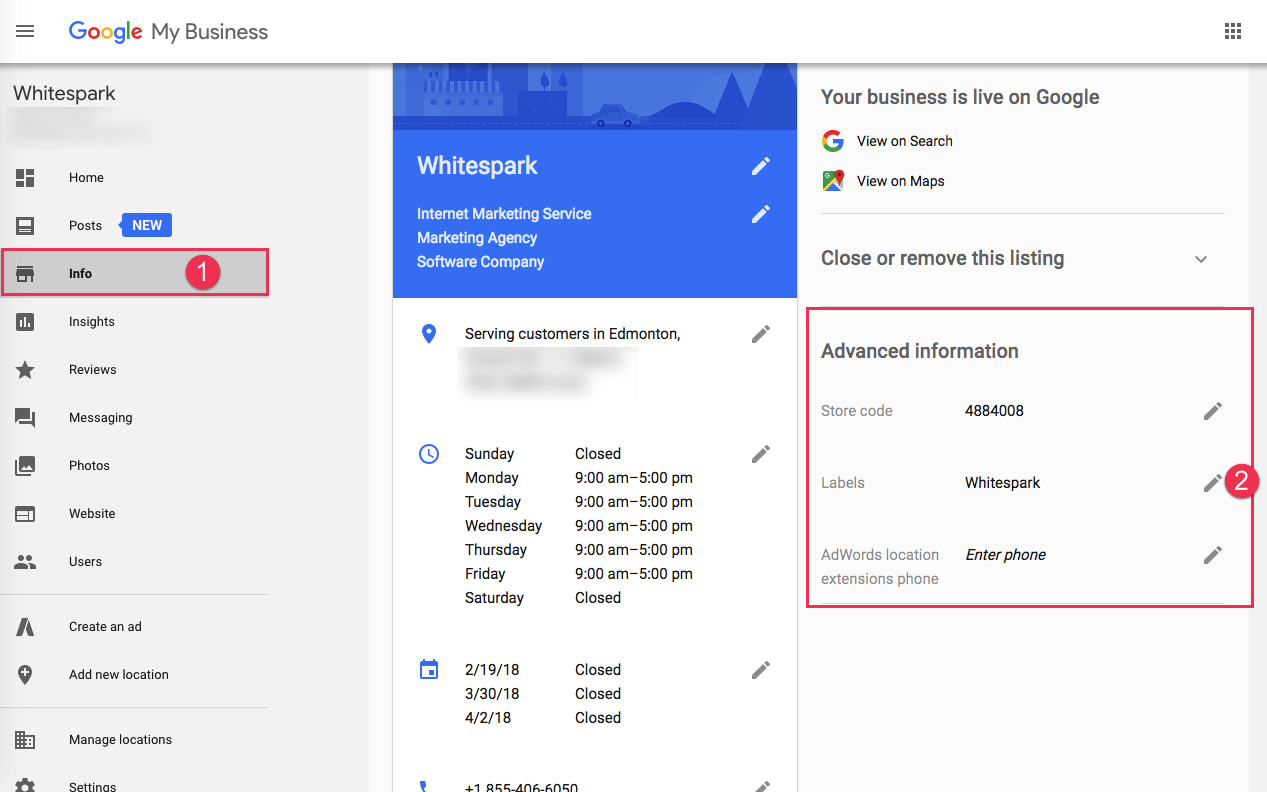
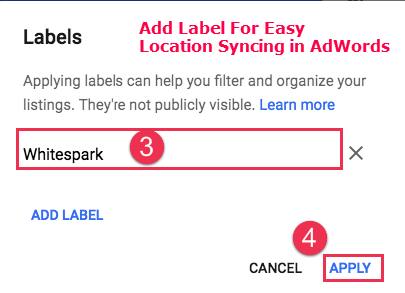 Joy: So, I could put, like, a Whitespark label on your listing there, Darren. And then, when I’m connecting the two, you can specifically say you just want to import the one with the Whitespark label. It’s actually a field in Google My Business. Under the “Advanced Information,” there’s, like, these three fields. You can’t get to it in AdWords, but it’s in the Google My Business dashboard, and there is, like, a label field there. So, I found the label field is really great for keeping it organized in only importing the one location that you actually want with this campaign.
Joy: So, I could put, like, a Whitespark label on your listing there, Darren. And then, when I’m connecting the two, you can specifically say you just want to import the one with the Whitespark label. It’s actually a field in Google My Business. Under the “Advanced Information,” there’s, like, these three fields. You can’t get to it in AdWords, but it’s in the Google My Business dashboard, and there is, like, a label field there. So, I found the label field is really great for keeping it organized in only importing the one location that you actually want with this campaign.
Darren: Yeah, that’s interesting. I noticed that. I started playing around with this and I tried to set one up. I added this location extension. And when I was messing around with this, it did ask me, like, what did I want to add. Here. So, I go “Plus,” right? And then I can go “Location Extension.” And then I can sync it to a specific business. Sorry. I’m not very good at AdWords here. But all sync locations. One location selected. So, yeah, this is basically how you set it up.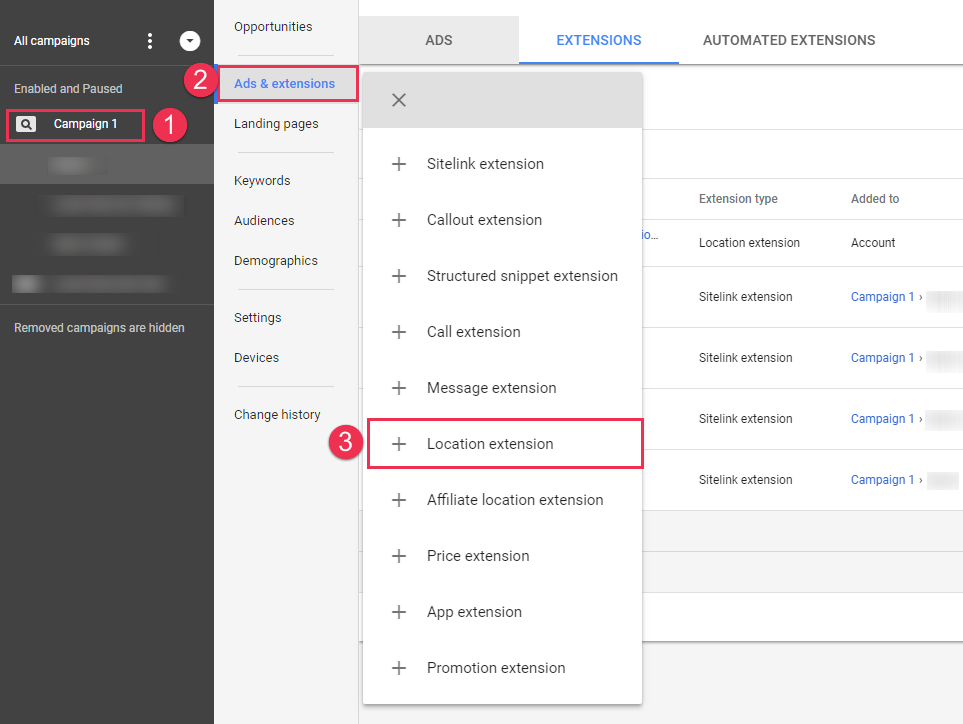
 Joy: The only reason why I don’t like doing the business name…because that’s another thing you can say, like, “Oh, I want, you know, to import the ones with business name, and that’s Whitespark.” I don’t know. Business names can change, so I usually just prefer to use a label because it’s just easier. You just need to make minor changes. But yeah, there’s the label field. I usually put, like, “label equals Whitespark” and then I pick something really small to label the client. I just find it’s easier.
Joy: The only reason why I don’t like doing the business name…because that’s another thing you can say, like, “Oh, I want, you know, to import the ones with business name, and that’s Whitespark.” I don’t know. Business names can change, so I usually just prefer to use a label because it’s just easier. You just need to make minor changes. But yeah, there’s the label field. I usually put, like, “label equals Whitespark” and then I pick something really small to label the client. I just find it’s easier.
Darren: Yeah, makes sense. I made a little ad to, sort of, figure out how this would work. But I can’t get my ad to show. So, tell me about that. I basically targeted these keywords. I’m trying to get my silly ad to show but, as you can see, no impressions so far. What’s the deal? How come I can’t get my ads to show? Joy: Well, Darren, you’re bidding 5 cents, so that’s probably the first problem.
Joy: Well, Darren, you’re bidding 5 cents, so that’s probably the first problem.
Darren: I was bidding $5, I thought? I set, like, my…
Joy: Oh, sorry. You know what? This screen is small. I think it says 95 cents. Maybe that’s a 9, but…
Darren: It says 85 here, auto 85.
Joy: 85, yeah.
Darren: I can edit it.
Joy: You’re definitely gonna have to bid higher. You know, I don’t know what the average cost per click is for the keywords you’re bidding on, but I think it’s pretty rare to see something that’s lower than $1 these days.
Darren: Okay, yeah. It’s on auto, so I don’t know. I was trusting AdWords to sort that out for me, but I guess not. I have to bid higher.
Joy: I generally don’t trust Google to manage things. And I know that’s my take on it, but… Essentially, you’ve gotta get your ad to show. So, why your ad’s not showing probably has nothing to do with how you set this up. It’s probably to do with the account itself.
If you’ve got an AdWords account and you’ve already got keywords set up and ranking really well, like you’re in the top three, you stand a good shot of having the three-pack ads show, as long as you’ve got the location extension hooked up. The key is that they show up based on the user’s location. So, it has nothing to do with the keywords you’re targeting. It has to do with where the user’s located.
So, like, when I was kinda messing around this morning, I was using the Mobile Moxie tool and, like, changing my location and doing a bunch of mobile searches. And when I first put in Edmonton as my location, I didn’t see any of the three-pack ads. But the moment I changed it to a postal code, which, zip code in the States, I was able to see an ad for some SEO company in Edmonton. So, they’re very hyper-local and they are really based on the user and their location.
Darren: Right. Yeah, let me demo that because I noticed that same thing. So, if I just do a search for, you know, “plumbers,” and then… So, on desktop, we don’t typically get them. But why don’t we address that first? How come these local pack ads…we see them on mobile, so if you open up your phone and do some searching, you’re definitely gonna see pack ads for things like plumbers or storage or insurance. But when I do it on my desktop, I don’t really get them. What’s the deal with that?
Desktop Example With No Ad: Joy: So, they definitely show up a lot less on desktop. One of the big things that I’ve noticed for the ones that I’ve seen for clients that show up on computers is usually it only shows for keywords that are related to your business name. So, for example, in this case, like, the “Bankers & Traders” one there, they probably would never show right now on computers because they don’t have word “insurance” in their business name. So, they wouldn’t show for, like, a keyword related to insurance, but they might for, like, if they were looking for bank keywords because the word “banker” is a part of their business name.
Joy: So, they definitely show up a lot less on desktop. One of the big things that I’ve noticed for the ones that I’ve seen for clients that show up on computers is usually it only shows for keywords that are related to your business name. So, for example, in this case, like, the “Bankers & Traders” one there, they probably would never show right now on computers because they don’t have word “insurance” in their business name. So, they wouldn’t show for, like, a keyword related to insurance, but they might for, like, if they were looking for bank keywords because the word “banker” is a part of their business name.
Darren: That’s interesting, yeah. Well, if you’re doing a re-brand, then you should certainly look at getting some keywords in your business name. So, I wanted to show, like, these ads change depending on where I am on the map. So, as I zoom around, you’ll see the ads. So, there’s no ads here, but as I kinda move around, I’ll get different ads popping up.
Local Finder Example 1: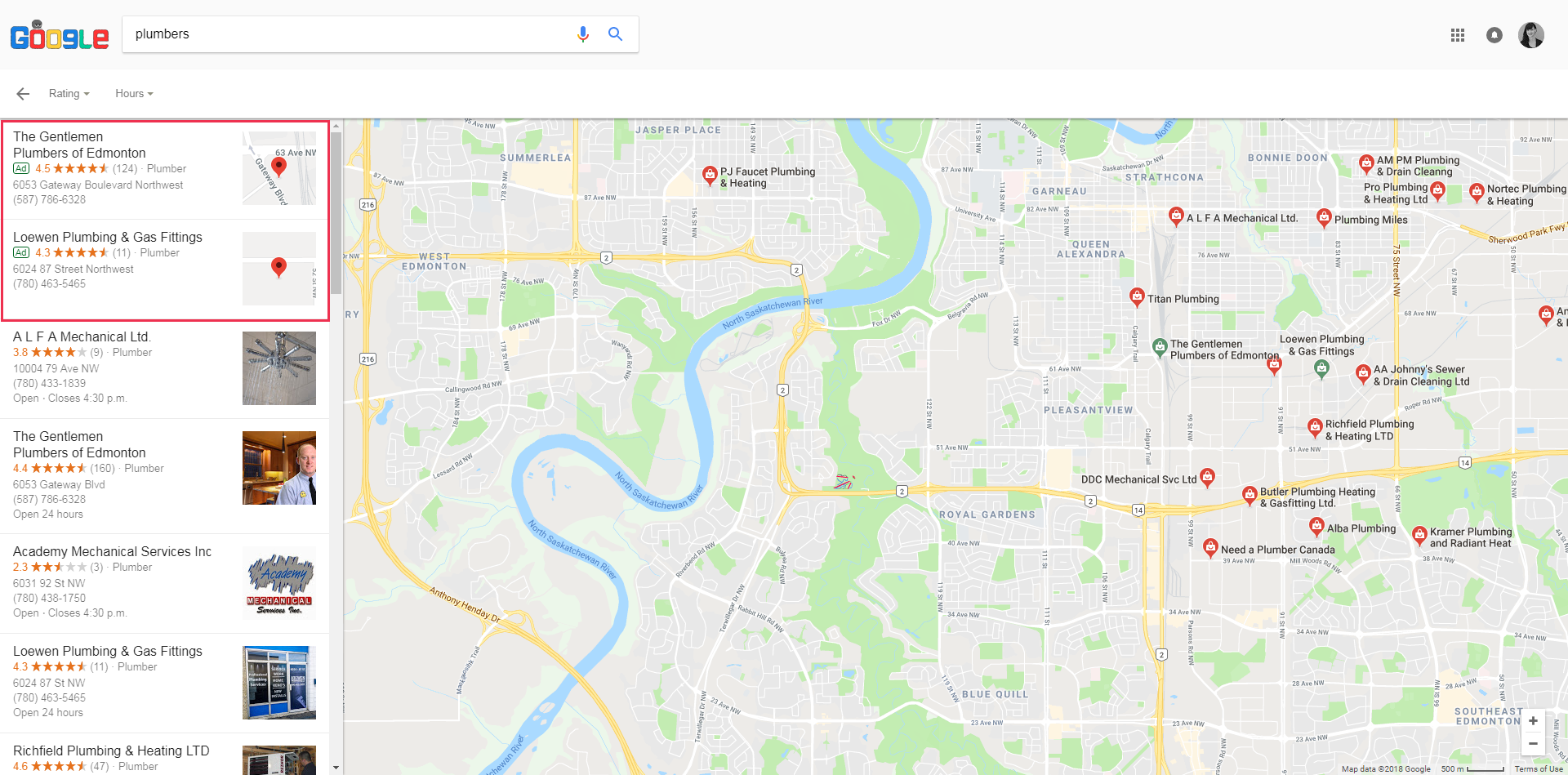 Local Finder Example 2:
Local Finder Example 2: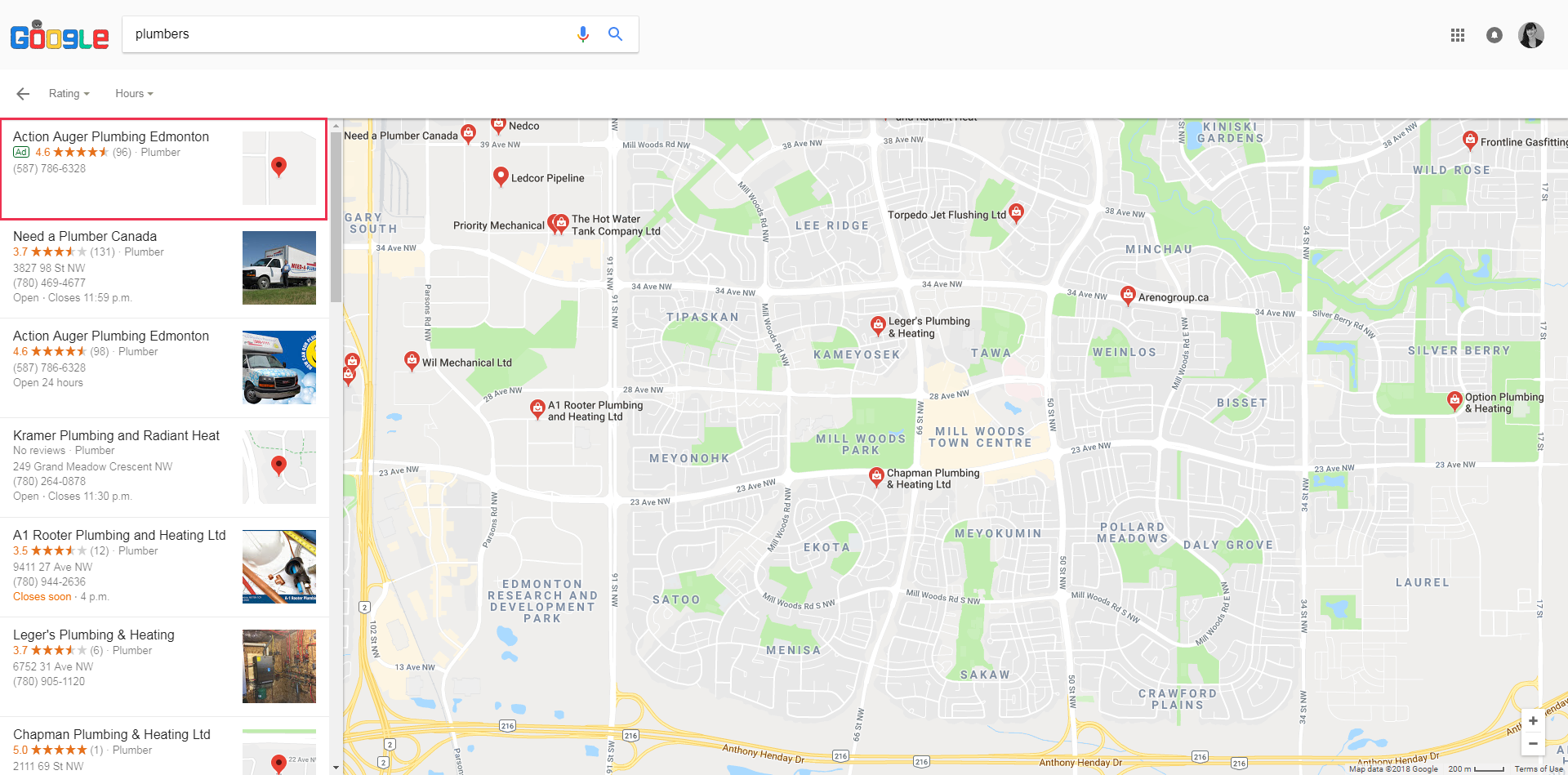 Joy: Yeah, and just to confuse you, these ads don’t always match what you see on three-pack ads, too. So, they’re both taken from the same thing, which is location extensions. So, if you have an ad here, you’re eligible to have an ad in the three-pack. But, like, the ones that you see are gonna vary based on your location and where you’re searching for. So, as you kinda zoom into areas, you’ll see ads for businesses in that area.
Joy: Yeah, and just to confuse you, these ads don’t always match what you see on three-pack ads, too. So, they’re both taken from the same thing, which is location extensions. So, if you have an ad here, you’re eligible to have an ad in the three-pack. But, like, the ones that you see are gonna vary based on your location and where you’re searching for. So, as you kinda zoom into areas, you’ll see ads for businesses in that area.
Darren: Right. And then I noticed that these ads show up on the Google Maps app as well. So, like, is there a way to say, “Okay, I want my ads to either only be in the local pack or only be in Maps, or only be in the local finder?”
Example of Ad in Maps: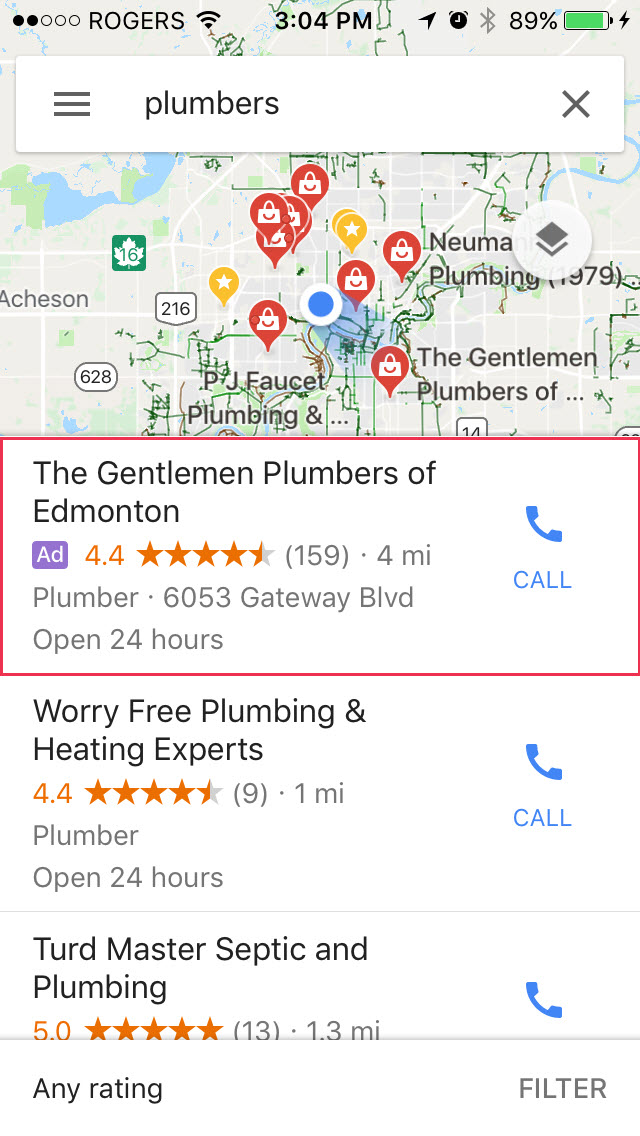 Joy: No. Actually, it’s funny because the AdWords help center, like, doesn’t even really address these types of ads at all. But no, there’s no way to distinguish it right now. It’d be kinda cool if you could, but I guess Google assumes that, you know, if it works one place, it’s probably gonna work in all of them.
Joy: No. Actually, it’s funny because the AdWords help center, like, doesn’t even really address these types of ads at all. But no, there’s no way to distinguish it right now. It’d be kinda cool if you could, but I guess Google assumes that, you know, if it works one place, it’s probably gonna work in all of them.
Darren: Yeah. So, these ads are basically just the same as a regular AdWords ad. So, you specify a campaign, an ad group, you create an ad, and then you just add location extensions and you hope Google shows it. It’s pretty much that, right?
Joy: Yeah, they’re really based on keywords. So, you definitely have to have the keywords in your account. But the one thing that I found is, like, let’s say you’re in Minneapolis and your business is in Minneapolis. You could actually show up for, like, “auto insurance Minneapolis” or “auto insurance St. Paul.” It doesn’t matter if the search term actually has “St. Paul” in it. If the person searching is close to you in Minneapolis, they’ll still see your ad.
So, that’s, kind of, a feature I think a lot of business owners will love because as long as the, you know, searcher is close to you, they can put in a different city and you’d still appear, which is kinda cool.
Darren: That’s cool, yeah. So…
Joy: But, yeah. They’re different, too, because they don’t use ad text. They use the business name as it is in Google My Business. You cannot customize how it looks, which is kinda irritating.
They also don’t seem to really factor in quality score much. Like, quality score has a lot to do with the ad itself. So, we’ve seen cases where, like, people with terrible quality scores like 4 or 5 still technically have the three-pack ads showing, even though, by AdWords terms, they shouldn’t.
Darren: Oh, that’s interesting, yeah. So, these are not impacted by quality score. They’re more impacted by location and keywords.
Joy: Yeah, I think Google’s, like, treating them kinda separately and really basing it on the location and then, obviously, the business name. They look at that. I don’t think they look at categories. At least, I haven’t found any evidence to suggest that they do. So, it’s, kind of, a really simple setup. I feel like they should probably make it a little easier to customize.
Darren: Yeah, that’s true, actually. I noticed a really interesting thing is when I searched on my phone for “car insurance,” I got an ad for a mortgage broker. So, that tells me that that mortgage broker’s campaign is too broad. Like, the keywords that they’re targeting are too broad, and so they’re coming up in local pack ads for terms that aren’t really relevant to what they do.
Joy: Yeah, which is a very common AdWords problem.
Example of Irrelevant Results From Broad Keywords in a Campaign: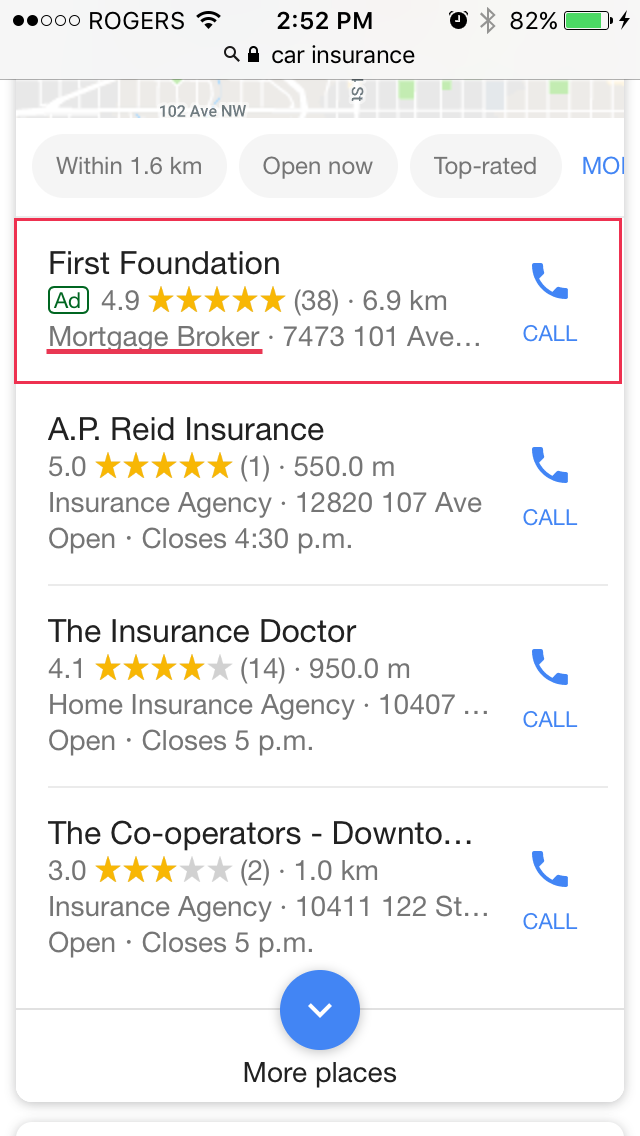 Darren: Right, that’s right. You know, because I imagine that the dream would be that you could just go into AdWords, make a new ad, and say, “This is the area that I want my ad to show in,” and you can maybe even specify zip codes or postal codes and target specific keywords. But it just doesn’t work that way. It’s pretty clunky. All you really can do is you make a regular ad, add the extension, and then the area is basically set at the campaign level, right?
Darren: Right, that’s right. You know, because I imagine that the dream would be that you could just go into AdWords, make a new ad, and say, “This is the area that I want my ad to show in,” and you can maybe even specify zip codes or postal codes and target specific keywords. But it just doesn’t work that way. It’s pretty clunky. All you really can do is you make a regular ad, add the extension, and then the area is basically set at the campaign level, right?
So, if I go into my campaign tests here… Let’s go into here. Where are my campaign settings?
Joy: There’s a “Settings” tab there on the left. Oh, there you go, under “Location.” So, just to clarify, you can’t really influence where these show up because Google only shows them based on the location of the searcher, not what you’re putting in here. And I don’t know how big of a radius they show them for. I didn’t test to see how far away I have to get before it stops showing. But they have to be close to you.
So, I would venture to say probably within, like, 5 to 10 miles. I think 10 is probably way too high. But, you know, within a 5-mile radius, you’re most likely gonna show, regardless of, you know, if the person typed in “Edmonton” or not. But you would not show up to someone in St. Albert because someone searching there is not gonna see you. They’re gonna see someone closer if someone else has location extensions enabled.
Darren: Really?
Joy: Yep.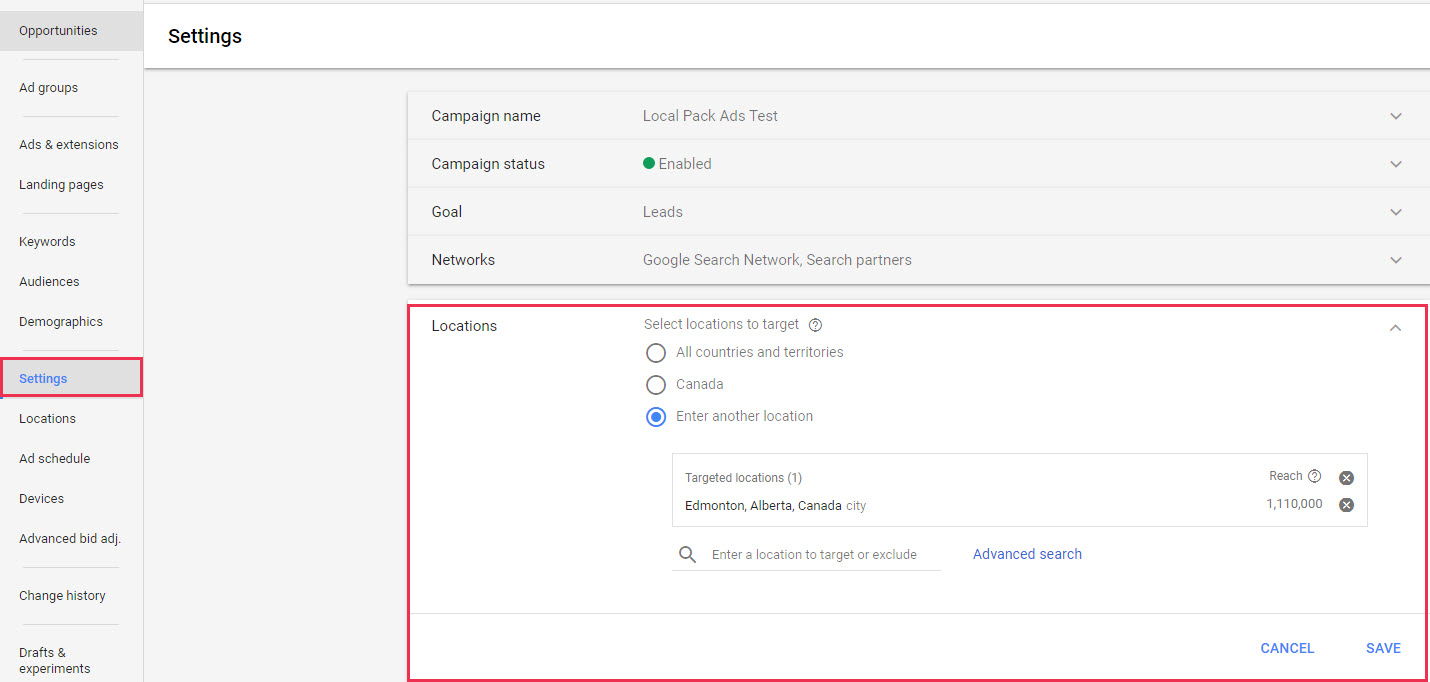
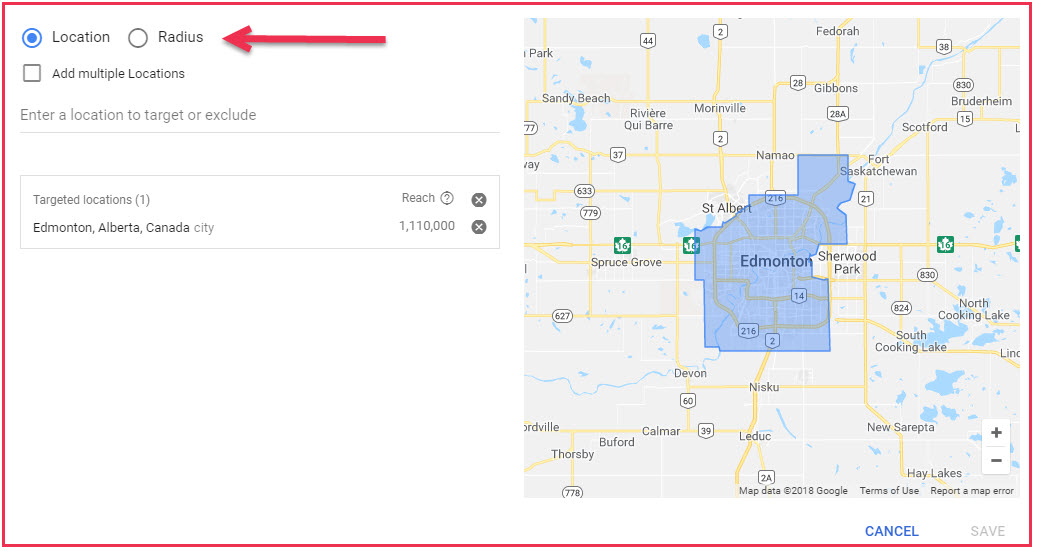 Darren: Is this guy close to me here? “U Store It.”
Darren: Is this guy close to me here? “U Store It.”
Joy: And again, Google might considering your location because you’re zoomed in. So, it might be using that, kind of, as a factor. And this was specifically for the ads in the three-pack. So, not the local finder. The local finder ads work slightly differently. But for, like, ads in the three-pack, we found it really varied based on the searcher’s location.
I remember when we were testing it out, we were using St. Paul or Minneapolis as an area to test it in because there’s so many cities within, like, a really small area. And then, the further we got away, the less the ad started showing, until it didn’t show at all. I just don’t know exactly what mile radius that is, but I know you can’t influence it. It had nothing to do with the location settings that we put in the AdWords account.
Darren: Right. Well, that’s interesting. In these local finder results here, I live right in this area here, but these are my two ads. And it’s funny how they’re clustered together. See how “StorageMart” and “Action Moving” are up here?
Joy: Mm-hmm.
Darren: Now, that’s interesting. Those two are there. And so, let’s zoom in and see if I get different ads.
Joy: And it might vary, too, as well, based on the industry. Because I know a specific client in lawn care who is 45 minutes-ish from my house, and I’ve been able to trigger his ad on my computer before. So, I think in his case, it’s more of the fact that there’s, like, no one else. So, that’s, I think, something else that could be factored in, whereas that probably wasn’t true with the insurance example we were looking at.
Darren: Yeah, and it’s gonna vary on desktop versus mobile, too, so it’s pretty hard to test that and, sort of, show you. So, I’ve got a bunch of other questions here. Do you typically put your Local extension ads…so if want to do Local extensions, will you make a new campaign for that, or will you just add it to your other campaigns?
Joy: No, definitely just add it to your existing campaign.
Darren: Just add it to your existing campaigns. And what’s the reason there? Just so you can take the benefit of the quality score and the information you’ve, kind of, built up in that campaign?
Joy: Yeah, and then you’ve got all the same keywords, right? I mean, the keywords you’d normally want your regular ads to show for would be the same keywords you’d want three-pack ads for. So, it rarely is different.
Darren: Right. Do you know if you can do this through AdWords Express, or do you have to have the proper, full AdWords?
Joy: I’m pretty sure you can. That being said, I’ve never tested one because I hate AdWords Express. But I haven’t heard anything to make me think that it’s not possible.
Darren: Okay, yeah. Oh, yeah, can you still get these to appear if your address is hidden and you’re a service-area business?
Joy: Yep. They work the same way. The only difference would be, obviously, that the directions icon won’t be there. Obviously, but, yeah.
Darren: Okay. But you definitely can still get them. Because I think that’s really valuable. I think, particularly, service-area businesses, you know, they wanna target a much wider radius. Now, that’s interesting, what you said earlier. So, let’s say my business is in St. Albert, which is a suburb of Edmonton, and I wanna get my ads showing in Edmonton. Are you saying I can’t do that, I can’t get local pack ads showing in Edmonton?
Joy: You can if the user that’s searching is, like, close to you in St. Albert. So, like, they could be typing in, like, “plumber Edmonton,” but it’s all based on how close they are to your business.
And then I think, also, how many other, you know, possible ads Google has. Like, you know, they look at all these different things.
Darren: Right. So, the local pack ads are not a solution to the proximity problem, that just trying to break your proximity in the local stuff, they don’t solve that, really?
Joy: Yeah. What is cool about them for people that are in the suburbs, though, is that, like, if, you know, people are in St. Albert, they might still search Edmonton because they think there’s more businesses there. So, in that case, you would be able to reach that person by typing in “plumber Edmonton.” You know, in the three-pack, you’re never gonna show up, but you can actually have an ad there. So, that part has been really cool.
Darren: Right. Is there any extra pricing? Like, do you pay more because you got the local extension, or it’s just part of your regular AdWords campaign?
Joy: It’s part of the AdWords campaign. So, we’ve seen that pretty much every single case I’ve ever looked at, the clicks are cheaper. I don’t know why. It makes no sense.
Darren: All right. Well, that’s interesting. Let’s see. Mike Blumenthal asked a question on Twitter, which I think is really interesting. So, given there’s just one space, you know, on mobile, how does Google run that auction, or how do they decide who gets to show? Do they rotate? You know, is it basically based on bidding? Like, what do you think?
Joy: Yeah, I think it’s a mixture of all of it. I think bidding definitely plays a role. You know, like, in your case, if you’re not bidding more than $1, you’re probably not gonna show anywhere. But as far as, like, the ad that they show, the definite number one thing would how close they are to me, like if I’m searching on my phone. So, that’s huge, and then, also, like, their business name, if it’s, you know, relevant to what I’m typing in, that kinda plays a role. But as far as how they choose which one, it’s kinda similar to, like, AdWords, you know? It’s based on a bunch of different factors and how relevant Google thinks the ad is and the click-through rate and things like that. So, typical AdWords stuff.
Darren: Typical AdWords stuff. Basically, the more you’re willing to pay, the more likely you are to show up.
Joy: Yes, as long as people are clicking. I definitely think click-through rate is one of those things you can’t really force. So, like, if you have bad reviews, for example, and you start advertising and your Google reviews do show up with your ad, there’s a case where I can see the click-through rate being crappy, and then your ad would probably eventually not show as much.
Darren: That’s a good point. So, that actually affects your quality score because if you’ve got really bad reviews, you get lots of impressions, no clicks, your quality score’s gonna go down. And then, the same thing, it could actually be beneficial to have the keyword in your business name because then you’re just kinda, “Oh, yeah, that’s what I’m looking for.” You’d be more likely to get the clicks, right?
Joy: Yeah.
Darren: So, if we renamed Whitespark, you know, “Edmonton SEO Company,” then we might get more clicks on our ads. Yeah.
Joy: You should really rethink that.
Darren: Well, we’re not gonna do that. All right. Are there any other specific things that you think people should know about these local pack ads? Any questions I didn’t ask?
Joy: No. As far as tracking them, so, just keep in mind that, you know, all the activity on them will never show up in Google Analytics, which is a bit of a bummer. But when you click on an ad, it doesn’t actually take you to the website. It takes you to the Knowledge Panel for the business. You aren’t gonna be able to do that there, but when you see an ad in the three-pack, that’s what happens. So, it’s kinda like those three-pack listings for…what do they call them, like, the image ones that have the image on it?
Darren: Yep. I know what you mean.
Joy: Yeah. So, it works the same way if you do the Knowledge Panel for the business. And then, they have nothing to do with call extensions. So, if there’s the call button on it, it is not pulling in from your call extension.
So, it’s a bit tricky on how to track them. But basically, what we do is we add a tracking phone number in Google My Business in the “Local Extensions” field, which is another one of those advanced fields that I was mentioning in Google My Business. And then we can literally track all the calls that happen because of the location extension, which includes three-pack ads. So, that’s how we do it.
And then I’ve found, like, I mean, the numbers are pretty phenomenal. But it definitely does not use your call extension phone number. So, it won’t show up there. It won’t show up under call details or anywhere in AdWords. You also can’t track conversions on it because, again, it doesn’t use Google Analytics. So, it’s kinda challenging from an AdWords perspective, but there are ways to do it if you’re using call tracking. Just use a call tracking number on the location extension.
Darren: Sure. And if they don’t call, what about, like, clicks to driving directions and stuff? You can’t really track that, or you just…
Joy: Yeah, you can segment it. So, if you segment by click type, they’re called “Get Location Details.” That’s the dumbest name ever, but that’s what Google calls them.
Darren: Okay, so you can get that data out of AdWords?
Joy: Yes. It just won’t tell you, like, “Get Location Details” means that they clicked on… You’re not gonna see it in your account because you don’t have any data yet or clicks. But if you go to the “Campaigns” tab… Well, I guess, in your case, you could just click on the campaign name on the left-hand side there and then go to the…there you go.
Darren: Do I already have it?
Joy: If you go to… Sorry, I’m, like, “Your screen’s small here.” So, you can segment by click. So, you can do that, like, either in keywords under the ad groups level. Yeah, if you click there, I think there should be an option to segment, which is one of these things here. So, it is…no. So, I think it’s one of those lines.
Darren: Those lines?
Joy: On the right-hand side next to the “Filter” button.
Darren: The right-hand side next to the “Filter” button. Oh, yeah, this one.
Joy: Yeah, one of those lines will segment. There you go. That one, yeah. And then can go “Click Type,” and then there would be a line there. You don’t have any data, but there would be a line there that would basically say, like, “Headline,” “Site Link,” “Mobile Clicks to Call,” which is our call extension data, so there’s nothing to show there. But then there’s another one called “Get Location Details,” and it’ll show you how many clicks you got, which those are people that clicked on the listing to expand your Knowledge Panel, essentially.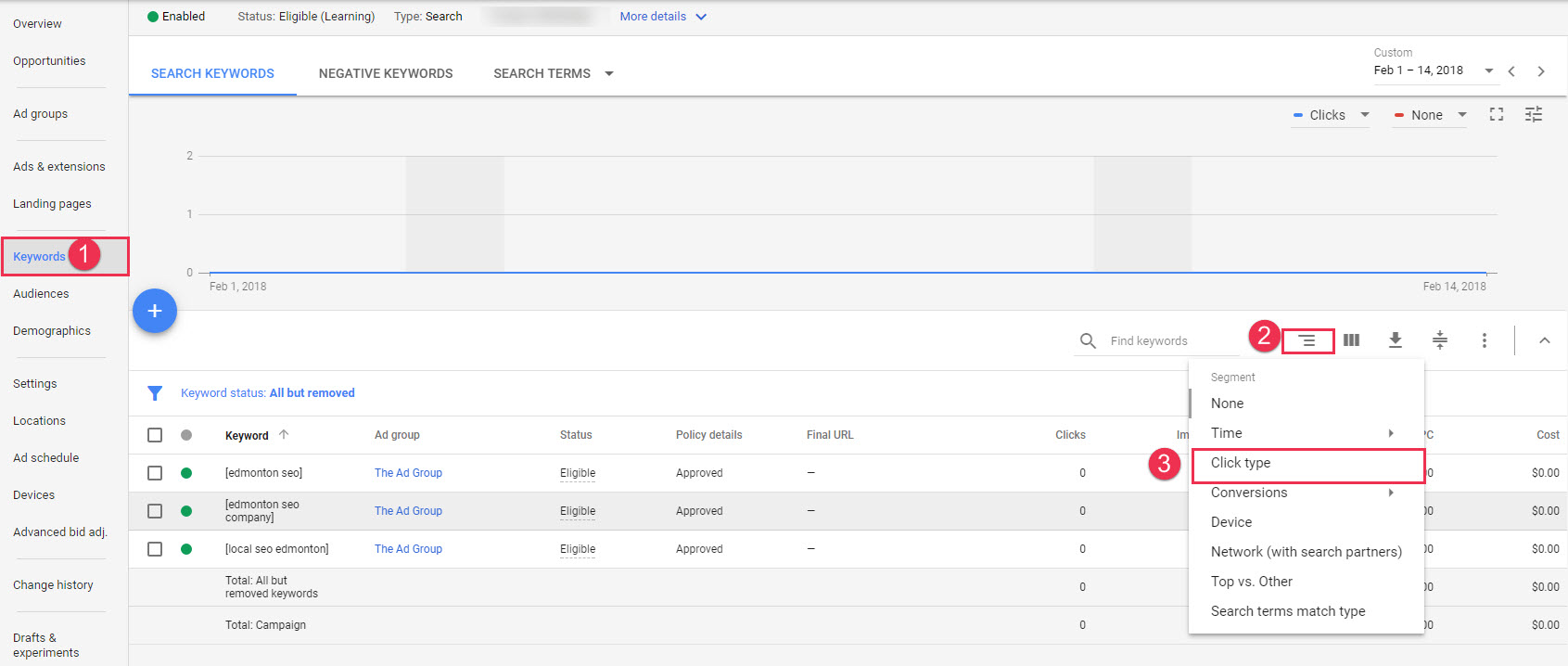 Darren: Right. Oh, that’s cool. So, you can get that data out of AdWords.
Darren: Right. Oh, that’s cool. So, you can get that data out of AdWords.
Joy: Some data. It’s just hard to do anything with it. That’s why I like the call tracking option.
Darren: Yeah. Well, I gotta say, I’m pretty disappointed that this does not really break the proximity problem where, you know, you’re mostly just gonna rank within your area around your business. I think you probably can expand your radius a little bit with the ads. Google’s gonna show you a little bit wider. But it doesn’t mean a service-area business can target all the different cities and all the different areas, which is too bad. I guess you gotta go back to the organic results and organic ads as well.
Joy: Yeah. I mean, but keep in mind, I’ve seen really good success from suburbs. So, if you’re in that boat, it is, I think, still helpful. Much better than, like, before. If people search the main city, then you do show up.
Darren: Absolutely. And I think, you know, that’s the point. You wanna drive more traffic from search and more calls, more leads, more business from search. These ads are another way to do that. And, as you mentioned, they seem to be a little bit cheaper than regular ads, so it’s kind of a no-brainer. It’s useful to set it up and turn these on. And as long as you can validate the return on investment and if it doesn’t cost that much, since it’s such a small locale, I think there’s good advantages to setting these up.
Joy: Absolutely. No reason not to.
Darren: Okay. Well, thank you, Joy. I appreciate having you on the show. And I guess that’s it.
Joy: All right. Thanks for having me.
Darren: Okay, yeah. So, if anyone needs AdWords help, I really recommend Joy. She’s awesome. That’s why I asked her to come on. So, you can check out her company, Sterling Sky. All right. Okay. Thanks, everybody. Have yourself a good weekend. Bye-bye.